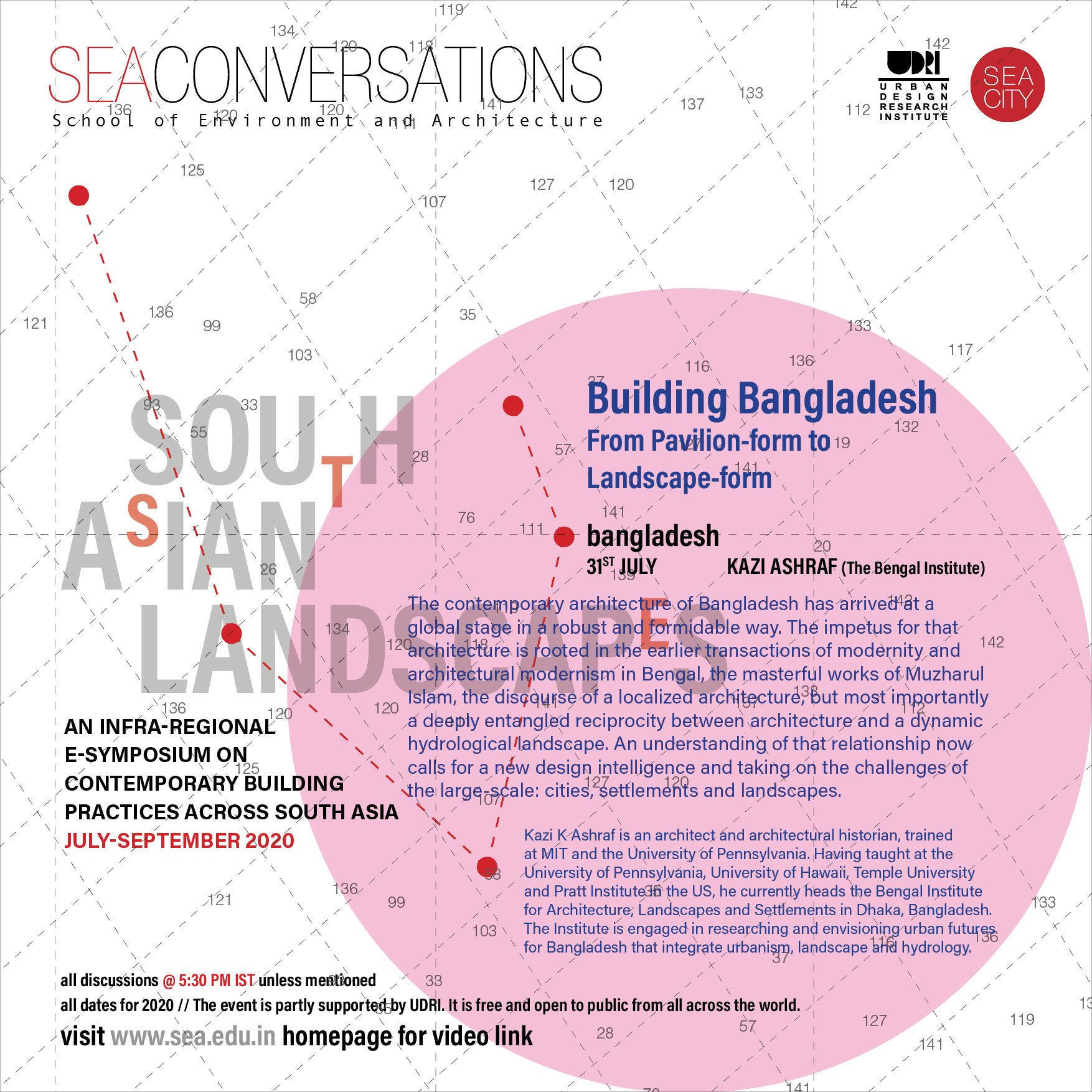SEA Conversations
South Asian Landscapes
Monsoon 2020
The South Asia Research cluster conceived of a semester-long e-symposium on South Asian built landscapes under its fortnightly outreach programme SEA City. In many ways, the physical immobility induced by this pandemic helped us articulate a pan-regional dialogue through which we could bring together voices from South Asian countries (including Nepal, Bangladesh, Pakistan and Srilanka) to discuss the emerging architectural and urban practices within the region. As part of this initiative we hope to nurture institutional networks towards a collaborative environment of research and intellectual exchange.
South Asian Architecture and Urbanism has remained an area of long-term investigation for the School of Environment & Architecture. Along with the continuing historical threads, cultural similarity and shared colonial past, South Asian countries have been working towards articulating a critical discourse in shaping its built environment today. How can architecture mediate cultural and political forces that emerge from our common past? What role may architects and spatial practitioners play in building relevant futures for South Asia? How can we respond to the distinct social tectonics that shape its people and place? What practices of the built environment from the past and present remain unrecognized in South Asia and how can these be deployed into a meaningful future? These are questions that the SEA City Conversation sought to address over the online semester-long series, titled “South Asian Landscapes'' planned in the light of a virtual borderless environment compelled by the COVID-19 pandemic. This cultural exchange aimed at preparing the ground from where a post-colonial inquiry into architectural and urban research for South Asia may be furthered.
The invited spatial practitioners and scholars were Roshan Mishra, director at Taragaon Museum in Nepal, Nripal Adhikari, director of ABARI, a contemporary architectural practice in Nepal, Kazi Ashraf, Architect and Historian and head of Bengal Institute for Architecture, Landscape and Settlements in Bangladesh, Salauddin Patash, who runs a collaborative practice called Atelier Robin Architects, and is Director of the Curatorial Programme at the bengal Institute, Anoma Pieris, Architectural Historian and Professor at the Faculty of Architecture Building and Planning at the University of Melbourne, Narein Pereira, architect who runs an innovative practice that focuses on passive strategies in architecture and teaches at the Moratuwa University, Ranjith Dayaratne, Professor of Architecture at the Department of Architecture and Interior Design at the University of Bahrain, Arif Hasan, architect, planner and activist, Yaminay Chaudhri, architect and artist who runs the Karachi beach radio and is a visiting critic at the Rhode Island School of Design’s Interior Architecture Programme and Prasad Shetty, dean at School of Environment and Architecture.
Roshan Mishra’s lecture titled ‘A Repository of Nepal’s Architectural Heritage’ took us through the Nepal Architecture Archive at the Taragaon Museum as well as the architecture and conservation of the Museum. Nripal’s lecture titled ‘Building Craft as Rebellion’ discussed ABARIS’s design processes that reclaim some of the traditional construction practices, making for beautiful and hazard resistant buildings as a challenge to the now rapidly growing ubiquitous concrete construction. Kazi Ashraf’s lecture titled ‘Building Bangladesh from Pavilion form to Landscape form’ took us through a survey of contemporary architecture in Bangladesh built on the foundations of practices of the likes of Mazhrul Islam, with a deeply entagled reciprocity between architecture and Bangladesh’s dynamic hydrological landscape. He called for this design intelligence to be scaled up towards more sustainable cities, settlements and landscapes. Salauddin Patash, in his lecture titled, ‘A Path of Curiosity in Architecture’, drawing on questions of intimacy, curiosity and memory, spoke about a practice that transcended building making to encompass ideas of life and living. Anoma Pieris’s lecture titled, ‘Spatialising Sovereignty and Civil war in Sri Lanka’, examined the changing spatial contours of Sri Lanka during wartime, offering new insights into human displacement, ethno-national consciousness and neo-liberal politics. Narain Pereira in his lecture ‘Developing Cities in the Tropics, the need for a climate responsive approach, stressed on the importance of a passive solar architecture. Ranjith Dayaratne, in his talk titled, ‘Vernacular Architecture of Sri Lanka and its Spatial Logics’, took us through the spatial logics of rural vernacular architecture. Arif Hasan, in his talk titled ‘The Changing Nature of Informal Settlements in Karachi’, laid out his practice of working in urban poor neighbourhoods in Karachi and the politics of land and development in the region. Yaminay Chaudhri, in her talk titled ‘Abe Guum’, went over her recent collaborative works with Karachi Beach Radio, discussing urban infrastructure collapse and loss of the commons along the coastal border of Sindh. Prasad Shetty’s lecture titled, ‘What is at Stake?’ discussed the various dimensions of spatial culture.








